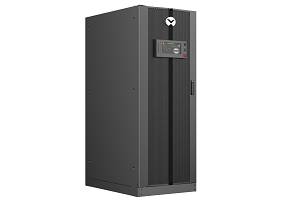IBC, like NAB, has become somewhat predictable. You know before you head out to the exhibition and its parallel conference that most of the discussion will be about 3D.
p>IBC, like NAB, has become somewhat predictable. You know before you head out to the exhibition and its parallel conference that most of the discussion will be about 3D.
3D broadcasting has now gained sufficient momentum to fly, at least as an extra option in an industry that has become highly divergent. A few years ago, the average television channel was broadcast in standard-definition 4:3 and viewers' only choice was whether or not to switch on. Today, many channels are offered in a choice of SD or HD with the further option of a 'one-hour-later' catch-up version via satellite plus up to a 'one-week-later' internet stream. 3D looks a natural addition to that list.
IBC2010 attendance was claimed to be the second highest in the show's 43-year history, at 48,521 compared with 49,250 in the peak year of 2008. General feeling among the 1,300 exhibiting companies was that visitors were in more serious buying mode than last year. The 'spend to save' concept certainly applies in broadcasting given the ever-improving cost-efficiency of software-based products running on standard Microsoft or Apple platforms, and some very attractive new developments in low-cost high-definition cameras.
Several major corporate acquisitions were announced shortly before the show. A San Francisco based company called 'Now Francisco Partners' has committed to buying Grass Valley from Technicolor. Completion is expected by the end of Q4. Grass Valley dominated the production switcher market in America and Europe before coming under intense pressure from competitors. Quebec-based Miranda Technologies announced that it had acquired UK-based automation system manufacturer Omnibus Systems. Prague-based KIT Digital announced that it had acquired the assets of UK-based system integrator Megahertz from the latter's Canadian parent company, Azcar Technologies.
Awards bestowed
An increasing number of trade organisations and publications are bestowing trophies for new or innovative devices in their particular sphere of interest. The International Association of Broadcast Manufacturers presented its 2010 IABM Peter Wayne Award for Design & Innovation to Mode-AL for its Speed Rack, a quick-build alternative to 19 inch racking requiring no additional tools or hardware. Four IABM Awards for Excellent winners were also named:
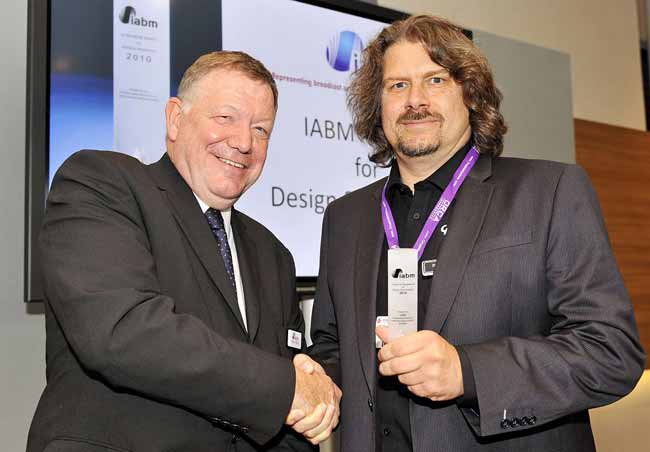 Dolby for its PRM4200 film grading system; Gekko Technology for its kleer colour LED-based multichip array technology; Integrated Microwave Technologies for its RF Central Microlite HD MPEG-4-based HD wireless link; and Sony for its MPE-200A 3D stereo image analyser and manipulator.
Dolby for its PRM4200 film grading system; Gekko Technology for its kleer colour LED-based multichip array technology; Integrated Microwave Technologies for its RF Central Microlite HD MPEG-4-based HD wireless link; and Sony for its MPE-200A 3D stereo image analyser and manipulator.
The IBC itself has long history of issuing awards, not quite on the same scale as the 59 bestowed by the organisers of the 2009 SIEL and SATIS show in Paris but in the same spirit. Nine IBC award winners were announced including Manolo Romero for masterminding Olympics sports coverage over many years, BSkyB for launching the new Sky 3D channel, and NDS for Best Conference Paper ('Does size matter? The impact of screen size on 3D').
Audio
Eyeheight 's new HD Voiceover audio combiner allows AES audio sources such as voice or audio effects to be mixed with an existing HD-SDI embedded audio stream. Designed for use in broadcast studios, post-production facilities or playout centres, HD Voiceover can be controlled via automation, Eyeheight 's FP-9 panel with multi-level colour-coded pushbutton menus, or via GPI. Features include input channel manipulation, programmable automatic voice-over transitions and EDH re-insertion. Integral solid-state memories are provided to store six groups of user-configuration data. Manual or motorised fader operation is optional. The mixer is fully transparent to all other embedded signals.
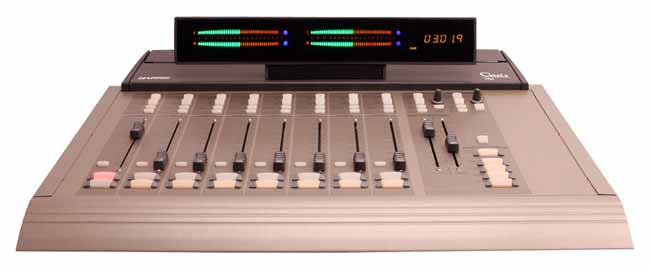 Harris Corporation introduced the PR&E Oasis on-air and production console available with eight or 12 channels. It incorporates analogue and digital outputs and provides multiple connections for microphones, CD players, monitors and a direct PC automation channel. Two telco channels can be assigned to any fader. Other features include swappable input cards and USB recording/replay.
Harris Corporation introduced the PR&E Oasis on-air and production console available with eight or 12 channels. It incorporates analogue and digital outputs and provides multiple connections for microphones, CD players, monitors and a direct PC automation channel. Two telco channels can be assigned to any fader. Other features include swappable input cards and USB recording/replay.
NTP Technology announced a new addition to its range of digital audio routing and processing equipment. The NTP 625 MADI router is a 2048 x 2048 crosspoint router in a single 19 inch 5 RU frame, complete with dual controller and dual power supply unit. Up to 18 MADI cards with four MADI input and output interfaces can be accommodated. Each frame has a TDM bus capacity of 2048 channels at 48 kHz sampling rate. Two frames can be interconnected using the NTP XBus connection for a total of 3072 channels.
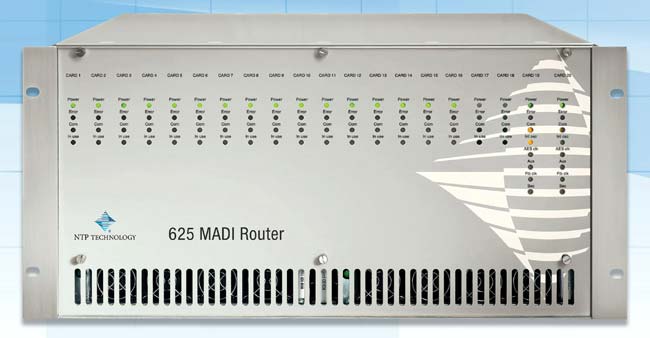 Tieline Technology's Report-IT Live is claimed to be the world’s first Apple-iPhone application that turns the iPhone into a wireless IP audio codec and sound recorder. The Enterprise Edition enables broadcast networks to manage multiple users from the studio using cloud computing concepts to programme, manage and secure live Report-IT connections across their IP networks.
Tieline Technology's Report-IT Live is claimed to be the world’s first Apple-iPhone application that turns the iPhone into a wireless IP audio codec and sound recorder. The Enterprise Edition enables broadcast networks to manage multiple users from the studio using cloud computing concepts to programme, manage and secure live Report-IT connections across their IP networks.
Zaxcom's new TRX900LT combines wireless transmission, recording, and remote control receiving functions into a single lower-cost system for the production of studio and live broadcast events. An internal timecode-referenced audio recorder backs up all wireless transmissions on a removable microSD card as a backup in case of audio loss over the transmission link. Each TRX900LT unit will operate for up to five hours on a single AA-sized lithium battery and is compatible with all Zaxcom wireless receivers and IFB transmitters. An integral ZaxNet 2.4-GHz RF network enables distribution of remote control signals, timecode and metadata.
Cameras and optics
 Camera Corps' new Multi Camera Keypad Control Unit increases from five to 96 the number of remote camera heads that can be operated via the company's Joystick Control or CCU Panel. The keypad can also be used with Camera Corp's Multi Camera Combiner unit to allow up to four Joystick operators and up to four CCU engineers to control the 96 cameras and pan & tilt heads simultaneously using just a single data line. An output is provided to drive many different types of video router, enabling the picture monitor to follow camera selection at any of the eight operator positions. Up to 255 channel numbers and routing-matrix assignment numbers can be selected via the keypad for easy integration of the 96 camera sources with existing camera channel configurations on video matrices with up to 256 inputs.
Camera Corps' new Multi Camera Keypad Control Unit increases from five to 96 the number of remote camera heads that can be operated via the company's Joystick Control or CCU Panel. The keypad can also be used with Camera Corp's Multi Camera Combiner unit to allow up to four Joystick operators and up to four CCU engineers to control the 96 cameras and pan & tilt heads simultaneously using just a single data line. An output is provided to drive many different types of video router, enabling the picture monitor to follow camera selection at any of the eight operator positions. Up to 255 channel numbers and routing-matrix assignment numbers can be selected via the keypad for easy integration of the 96 camera sources with existing camera channel configurations on video matrices with up to 256 inputs.
Canon claimed a 'world's first' for its HJ15ex8.5B KRSE-V portable HD zoom lens with optical image stabilisation. An HD alternative to the company's J13x9 KRS VAP SDTV, it offers a higher zoom ratio and wider angle. Canon’s 'Vari-Angle Prism' provides image stabilisation throughout the whole zoom range from telescopic to wide angle. Four stabilisation modes are accessible to meet a variety of shooting conditions.
Fujinon introduced four new B4 mount lenses designed for 3D HD production. The HA23X7.6BEZD-T5DD offers a 23x zoom with a focal length of 7.6 - 175 mm (15.2-350 mm with 2x extender). The HA16X6.3BEZD-T5DD offers a 16x zoom with a focal length of 6.3-101 mm (12.6 - 202 mm with 2x extender). The HA18x7.6BEZD-T5DD incorporates an 18x zoom with a focal length of 7.6 - 137 mm (15.2 - 274 mm with 2x extender). A fourth HD lens, the HAs18X7.6 3BZD-T5DD, is an 18x zoom with a focal length of 7.6 - 137 mm with no 2x extender. All four lenses include Fujinon’s Inner Focus, Zoom Limit, and Quick Zoom features, with an optional 16-bit encoder.
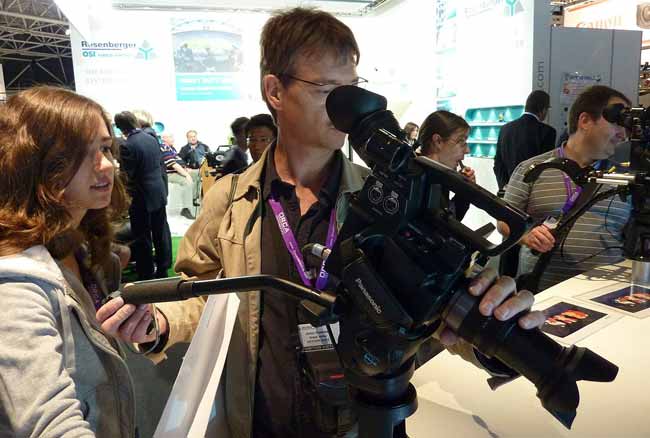 Panasonic exhibited a prototype 1080p solid-state camcorder intended to offset increasing competition from HD-video-capable snapshot-style cameras. The AF101 can operate at up to 60 frames per second and allows live video monitoring via an HD-SDI output.
Panasonic exhibited a prototype 1080p solid-state camcorder intended to offset increasing competition from HD-video-capable snapshot-style cameras. The AF101 can operate at up to 60 frames per second and allows live video monitoring via an HD-SDI output.
Polecam announced two new additions to its range of lenses. The HRO 69 (High Resolution Optics) is a 3.5 mm lens designed specifically for use with latest-generation 1/3 inch miniature 3-CCD HD cameras. Compatible with cameras such as the Toshiba IK-HD1, Iconix RH1, Panasonic GP-US932 and Ikegami MKC300, it has a 3.5 mm focal length, 69 degree horizontal angle of view and F2.2 to F16 aperture range. The Theia MY125M ultra-wide-angle effects lens made its European debut. It is designed for sports coverage where an entire goal mouth needs to be captured or for capturing video content in confined spaces such as a car. On a larger scale, it allows huge areas of a stadium to be covered from a single viewpoint without need for a pan-and-tilt unit. Barrel distortion is claimed to be less than 3 per cent.
Having opted out of IBC2009, Sony returned this year to promote its product range including a prototype 3D camcorder with dual zoom lenses plus the new 2D PMW-500 which captures to solid state SxS memory card. The PMW-500 has three 2/3 inch CCD sensors and can record 1080 or 720 HD at 50 Mbit/s.
Thales Angenieux extended its line of HD video lenses with the introduction of a 14 x 4.5 HD Video Wide Angle Lens. The new 14x4.5 AIF.HD ENG lens is a companion product to Angenieux’s 19x ENG and 26x telephoto HD video lenses as all three HD Video lenses in the line offer the longest zoom range in their respective categories.
Signal storage
Autocue announced four Linux-based video servers. These feature up to four bi-directional HD/ SD channels for simultaneous record and playout, and up to 12 terabytes of storage. Intended to replaced tape machines and for use in secondary broadcast roles, the servers are available now.
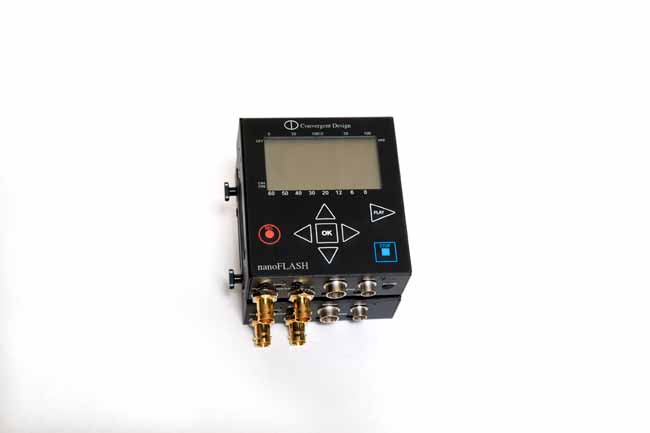 Convergent Design's nano3D dual channel video recorder combines two nanoFlash recorders/players, for fully synchronised stereoscopic capture and playback. Additionally, nano3D can also be used for simultaneous main and backup recording. Measuring approximately 75 x 100 x 100 mm and running on 12 W power, nano3D uses the 4:2:2 Sony MPEG2 codec but extends the bit-rate up to 280 megabit/s. Compressed video and audio are stored on Compact Flash in Quicktime or MXF file format.
Convergent Design's nano3D dual channel video recorder combines two nanoFlash recorders/players, for fully synchronised stereoscopic capture and playback. Additionally, nano3D can also be used for simultaneous main and backup recording. Measuring approximately 75 x 100 x 100 mm and running on 12 W power, nano3D uses the 4:2:2 Sony MPEG2 codec but extends the bit-rate up to 280 megabit/s. Compressed video and audio are stored on Compact Flash in Quicktime or MXF file format.
Infrastructure
Pharos announced its co-development of the OpenFARM rich-media analysis framework. Initiated by the Computer Vision laboratory of Kingston University, OpenFARM is a bridge between data-based driven asset management systems and independently developed software. OpenFARM is claimed to offer broadcasters freedom to add third-party software modules to their content management systems in essentially the same way that they select hardware for their central apparatus room. As an initial part of our involvement in OpenFARM , Pharos created two example plug-ins. One detects video scene boundaries. The other converts programme credits into searchable text which is used to create metadata such as the names and titles of performers and production crew.
Quantel'a new Qube is a video editor designed for latest-generation PC platforms running 64-bit Microsoft Windows 7. Part of the company's Enterprise sQ product range, Qube offers full server-based editing. It includes a new Quantel interface board handling 1080p and stereoscopic formats. These include side-by-side mode for stereoscopic viewing. Qube handles DVCPRO100, AVC-Intra HD and the full range of SD formats, and is fully integrated into the Enterprise sQ workflow. Price is claimed to be "extremely competitive" and will be announced when Qube is released in January 2011.
Test equipment
Blackmagic Design introduced the Pocket UltraScope is a small pod with a 3 Gb/s SDI input that connects to any USB 3.0 computer for waveform monitoring. When running on a notebook or desktop PC with a 1920 x 1080 display, it allows simultaneous display of six waveform views including RGB/YUV parade display, composite waveform, vector, histogram, eight-channel audio meters, stereo audio scope and picture view. When used with smaller screens, it allows a smaller 2 view window to be selected. Pocket UltraScope automatically detects the input video format, and switches between SD, HD and 3 Gb/s 1080p SDI formats. Blackmagic UltraScope is technically accurate, which is perfect for master monitoring and quality control tasks.
Cel-Soft introduced the Cel-Scope3D stereoscopic analyser. Compatible with all current versions of Microsoft Windows, it allows stereoscopic camera alignment to be performed quickly so that the 3D is accurate from the moment of capture. It can display left and right channels simultaneously plus depth dynamics. Each display window can be set to show the usual waveform, vectorscope and histogram graphics as well as differences in video parameters between each channel. Geometry issues can be easily identified using built-in real-time image manipulation. Quality-control tests can be performed on live stereoscopic video sources in any SD, HD or 2K format from industry standard capture cards or Firewire inputs, or alternatively from file playback.
Tektronix' Sentry identifies anomalies in the network at the IP, MPEG and content layers, identifying issues that represent the bulk of trouble calls from subscribers. Sentry performs deep inspection of every packet across hundreds of channels in real time. This ability far surpasses that of traditional monitoring probes and provides detailed reports which enable quick detection and resolution of issues. Sentry also provides visibility into other video and audio quality metrics including MPEG data and tables and embedded data.
Transmission
Hiltron Communications introduced the HDCU-E, a combined ice sensing and dish heating system for use with large satellite antennas. It is capable of handling up to 450 kW of heating power assigned across multiple heating groups. Each group is divided into three independently controlled heater arrays. Each array in turn feeds up to three antenna heater circuits. A four-group configuration, for example, allows control of 12 arrays addressing a total of 36 heating circuits. This modular control approach permits easy configuration of parameters such as antenna size, number of heater pads and the power requirement of each pad. Snow detection is via a reflective sensor with a polarising filter.
Rohde & Schwarz announced two new L-band transmitters to cover all broadcasting frequency ranges. The SCQ8000 TV transmitter achieves output powers of 300 W and 1200 W for DVB-T, DVB-H and MediaFLOTM. The SCL8000 attains powers of 400 W and 1500 W for DAB, DAB+ and T-DMB. Output powers of 1200 W and 1500 W can be implemented in 19 RU with four amplifiers, one control unit and one exciter. In the four-amplifier configuration, coupler, splitter, harmonics filter and lightning protection are integrated in a single unit. The amplifiers are equipped as standard with two power supplies. An optional third power supply can be integrated.
Future standard?
The Japanese broadcaster NHK, which originated what is now the 1920 x 1080 pixel HDTV standard back in the mid 1960s continues to keep up pressure for even higher resolution. Since 2003, NHK has been promoting its experimental Ultra High Definition (UHD) video system which has a resolution of 7,680 x 4,320 pixels. Given that 1920 x 1080 is almost overkill on a modern 40 inch LED display, NHK must be assuming a massive increase in the size of domestic living rooms to justify such a huge increase in resolution. BBC Research & Development in London is meanwhile conducting trials of the system with a view to relaying SHV feeds of the 2012 Olympics for viewing in cinema-style venues. If UHD catches on, it is not difficult to calculate the even higher resolution NHK will be advocating in 2025.
David Kirk














